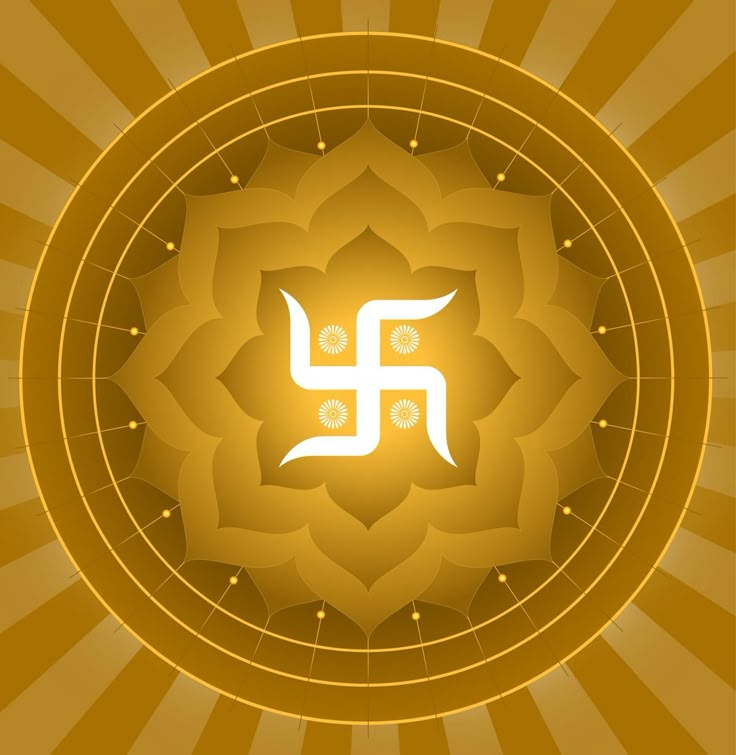Origin of Swastik, and How Important is it to Sanatana Dharma?
The swastika is one of the most ancient and revered symbols in human history, deeply rooted in Sanatana Dharma (Hinduism) and other Dharmic traditions like Buddhism and Jainism. Despite its unfortunate association with the Nazi regime in modern times, the swastika remains a sacred emblem of auspiciousness, prosperity, and cosmic harmony in Hinduism. This blog explores its origins, meanings, cultural significance, and spiritual importance within Sanatana Dharma.
Etymology and Symbolism
The word Swastika is derived from the Sanskrit term svastika, which combines su (meaning “good” or “auspicious”) and asti (“it is” or “to exist”), along with the diminutive suffix ka. Together, it translates to “all is well” or “it is good.” The symbol itself consists of a cross with four arms of equal length, each bent at right angles, forming a dynamic, rotating pattern that conveys movement and energy.
In Hinduism, the swastika is a visual representation of auspiciousness and cosmic order. It symbolizes well-being, prosperity, and good fortune. The four limbs of the swastika are interpreted in various ways:
- The four Vedas: Rig Veda, Yajur Veda, Sama Veda, and Atharva Veda.
- The four goals of life (purusharthas): Dharma (righteousness), Artha (prosperity), Kama (pleasure), and Moksha (liberation).
- The four stages of life (ashramas): Brahmacharya (student life), Grihastha (householder life), Vanaprastha (retirement), and Sannyasa (renunciation).
- The four yugas (epochs): Satya Yuga, Treta Yuga, Dvapara Yuga, and Kali Yuga.
The clockwise swastika (right-hand swastika) represents the sun, light, and life. It is associated with positive energy and auspiciousness. Conversely, the counterclockwise swastika (left-hand swastika) symbolizes night, Goddess Kali, and esoteric practices like tantra.
Also read:
5 Forgotten Vedic God
Historical Origins
The origins of the swastika can be traced back thousands of years. Archaeological evidence suggests that it was used as a sacred symbol by ancient civilizations across the world. It has been found in artifacts from the Indus Valley Civilization (circa 2500 BCE) as well as in ancient cultures of Egypt, Greece, Rome, Celtic Europe, Native America, and Persia.
In Hinduism specifically, the swastika first appears in texts like the Harivamsa Purana but is absent in earlier Vedic literature. It later gained prominence in epics such as the Ramayana and Mahabharata, where it was used to denote auspiciousness. The symbol’s universal appeal across cultures underscores its deep connection to humanity’s spiritual aspirations.
Spiritual Significance in Sanatana Dharma
The swastika holds profound spiritual meaning within Hinduism. It is considered a manifestation of cosmic order (rita) and divine energy. Here are some key interpretations:
- Representation of Divinity
- Many Hindus view the swastika as a representation of Lord Ganesha, the remover of obstacles. It is often drawn at the beginning of religious ceremonies to invoke his blessings.
- The clockwise swastika is associated with Lord Vishnu and solar energy. It symbolizes prosperity and dharma.
- The counterclockwise swastika represents Goddess Kali and lunar energy. It signifies transformation and protection against negative forces.
- Cosmic Symbolism
- The swastika is seen as a depiction of the universe’s cyclical nature. Its rotating arms signify perpetual motion around a fixed center—representing God or cosmic consciousness.
- It also symbolizes the muladhara chakra, or root chakra, which governs stability and grounding in spiritual practices.
- Sacred Geometry
- As a geometric figure with symmetry and balance, the swastika represents harmony between opposing forces—light and dark, creation and destruction.
Uses in Rituals and Daily Life
In Hindu culture, the swastika is omnipresent:
- It adorns temples, doorways, thresholds, account books, vehicles, wedding invitations, and even food offerings.
- During festivals like Diwali or Navaratri, it is drawn with rice flour or turmeric on floors to invite prosperity.
- It marks sacred spaces during rituals to ward off negative energies.
The symbol also plays a role in architecture (vastu shastra), where it represents balance in spatial arrangements.
Swastika Across Dharmic Traditions
While central to Hinduism, the swastika also holds significance in other Dharmic faiths:
- Buddhism
In Buddhism, the swastika represents universal harmony and eternity. It is often engraved on statues of Buddha or used to mark sacred texts. Tibetan Buddhists interpret it as a symbol of eternal truth. - Jainism
For Jains, the swastika symbolizes their seventh Tirthankara (spiritual teacher), Suparshvanatha. Its four arms represent the four states of existence: heavenly beings (devas), human beings (manushyas), animals/plants (tiryancha), and hellish beings (naraki).
Also read:
The Ramayana: The Ideals of Leadership and Family Values
Misuse During Nazi Germany
The sacred meaning of the swastika was tragically distorted when Adolf Hitler adopted it as a symbol for his Nazi Party in 1920 under the name hakenkreuz (“hooked cross”). This association with hatred led to widespread misunderstanding of its original significance. However, efforts are ongoing among Hindu organizations to reclaim its true meaning as an emblem of peace and spirituality.
Cultural Resilience
Despite its misuse in modern history, Hindus worldwide continue to venerate the swastika as a sacred symbol:
- In India, it remains integral to religious ceremonies.
- Globally, Hindu advocacy groups work to educate people about its original meaning.
Conclusion
The swastika stands as an eternal symbol of auspiciousness within Sanatana Dharma. Its profound meanings—encompassing cosmic order, spiritual goals, stages of life, and divine energy—make it an indispensable part of Hindu culture. While its historical misuse has cast a shadow over its reputation in some parts of the world, efforts to reclaim its sacred essence are gaining momentum.
As we delve into its origins and spiritual significance across millennia, we are reminded that symbols like the swastika transcend time and geography. They connect humanity to universal truths—truths that inspire harmony between individuals and their cosmos.
Support us by purchasing from our Affiliate Links:


Trackbacks/Pingbacks